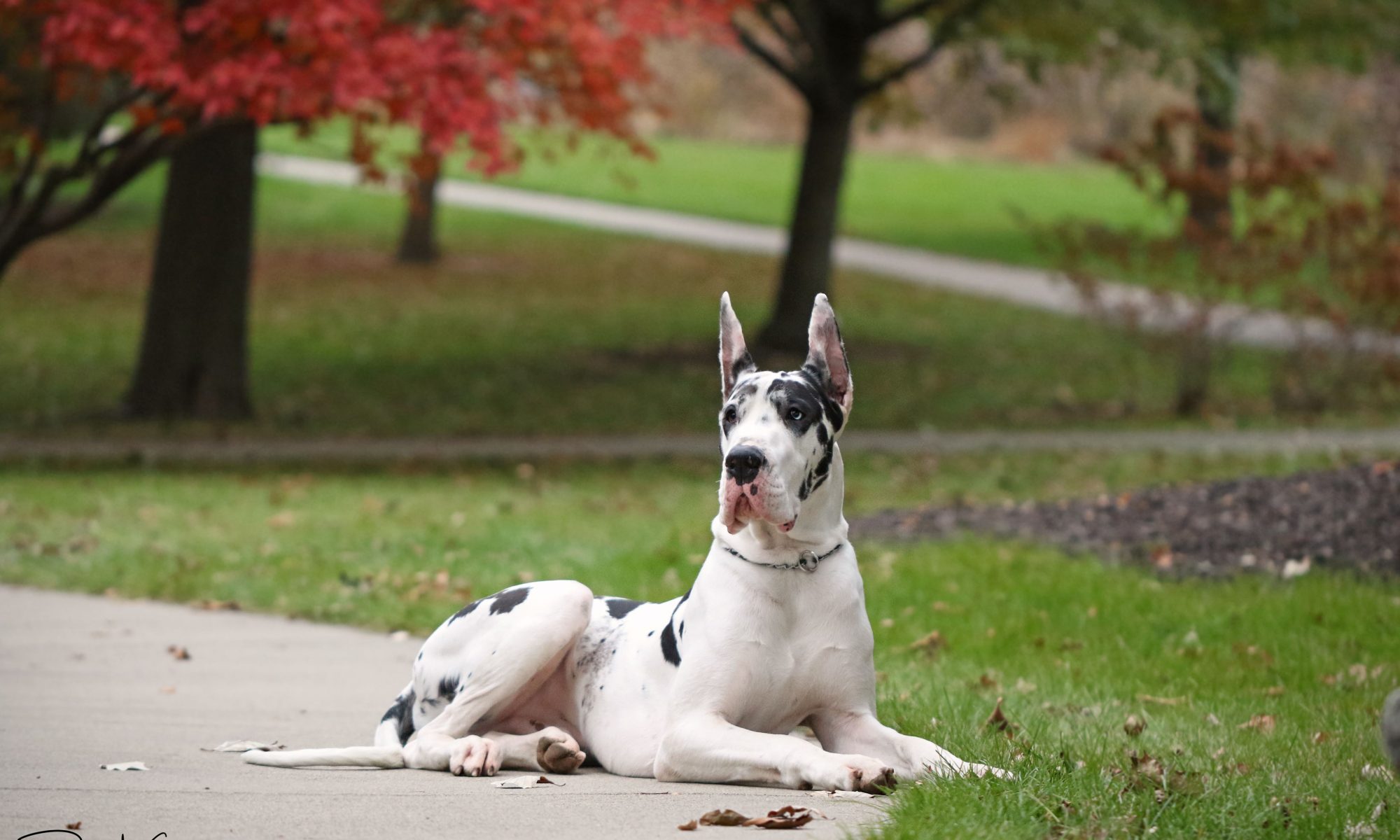Feeding Great Danes ~ Raw diets for dogs
The information about raw diets is not breed specific.
There are, however, some unique nutritional kibble requirements for Great Dane puppies that include not feeding puppy food.
In a nutshell, a raw diet consists of feeding your dog a variety of raw meat, bone and organ meat. Feeding raw takes some upfront research and one should have a good grasp on the concepts prior to starting. That said, raw feeding is not rocket science. It’s not difficult; it just takes some study.
When people first hear about raw feeding, inevitably, there is some surprise and sometimes aversion. It is different than what we have been taught to feed our dogs (no “people food”! no bones!). However, upon further research, many people have begun to understand and appreciate the benefits of feeding raw foods to their pets (cats, too!).
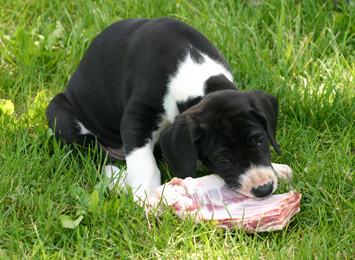
Raw feeding is not a new fad. In fact, kibble could be called the new fad, as it’s certainly not been around as long as people have had pets. Still, feeding kibble has been mainstream for many decades now, so thinking about feeding our pets something else seems strange at first.
Why Raw?
I started feeding my dogs a raw diet for various reasons. The concept behind a natural diet really made sense to me. The testimonials from other raw feeders were amazing – reports of better coats, less health issues, better appetites, cleaner teeth, less waste coming out the other end, and more.
It was the results, however, that have made me a firm believer. We had a Dane with severe canine acne on his chin. It was an unpleasant mess. His acne sores would become large and infected, frequently breaking open. We went through several rounds of antibiotics and topical medications, plus followed all the “normal guidelines” for dealing with canine acne (food/water only in clean stainless steel bowls, frequent cleaning of chin, etc.). Nothing really worked. Within two weeks of switching to a raw diet, his acne cleared up and we never had issues with it again. I was sold!
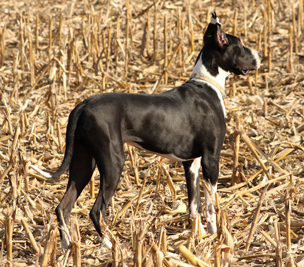
Raw diets provide a complete, healthy diet for dogs. They thrive on eating like nature intended. At the risk of sounding like a fanatic, the benefits are nothing short of amazing. Most of these benefits are quickly seen, for instance, a healthier coat and less waste. Other benefits are seen over time, like less frequent visits to the vet and cleaner teeth.
With raw diets, the owner has more control over the dog’s diet. Grains and fillers, that do not benefit the dog, are left out. Poor quality ingredients can be avoided. If an individual dog requires more/less of certain nutrients, it’s easy to adjust the diet accordingly.
For anyone whose dog has suffered from allergies, try switching to a raw diet for 2-3 months. Even if non-food allergens are supposedly to blame, raw diets often work to “cure” the dog.
Bones?! Yikes!
One of the first thing that worries people about raw diets is the consumption of bone. I’ve seen several concerned expressions when I say my dog eats bones!
Dogs can eat bones just fine. Just not cooked bones! Cooking bones dries them out, causing them to become brittle, sharp and dangerous for dogs to digest. Do NOT feed cooked bones.
Raw bones, however, are soft, pliable, consumable and a necessary part of feeding a raw diet.
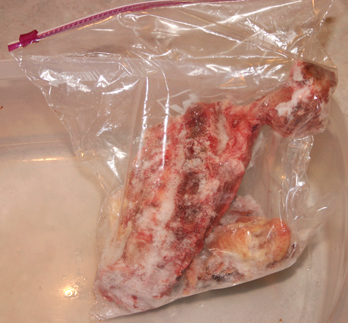
If in doubt about dogs being able to digest bone, visit a raw feeder’s house and look around in their backyard! In fact, waste from a raw-fed dog is unbelievably small and dissolves quicker than kibble-fed counterparts. Definitely a huge perk of raw feeding.
Bones are a critical part of raw feeding. One should not feed a raw meat diet without feeding bone. Without bone, there is an upset of important mineral ratios. Bone also helps to firm stools, so a diet of meat only would likely cause diarrhea.
For people worried about feeding bone or with dogs that would have difficulty eating bones, ground bone can be used.
If you don’t feed consumable bones, offer “recreational” bones. Raw beef knuckle bones are a great choice, ask your butcher for them. Kibble-fed dogs can get these as well, helping keep their teeth a little cleaner.
What about bacteria in raw foods?
Aside from feeding bones, this tends to be the other big concern about raw diets.
Dogs’ bodies are designed to eat raw foods and deal with the associated bacteria. To read more about this concern, visit Myth: The Bacteria in raw meat will hurt your dog.
Beyond concern for the dog’s ability to deal with the bacteria, there is often a concern about the handling of raw meat. The same cautions you would use when preparing meat for your human family applies. Hand washing and cleaning the area touched by raw meat. I’m careful to thoroughly wash my hands and any item/surface with which my human family comes into contact.
Is raw cheaper to feed than kibble?
I do not keep track of my monthly food bill for my dogs (call it denial!), but feel it is cheaper than how I was feeding kibble. When feeding kibble, I was choosing a premium kibble and often adding “extras” to the meal, along with vitamins and supplements. If the dog didn’t finish the meal, it had to be thrown out.
If a raw feeder is willing to do some bargain hunting, they could spend less money on raw than on a quality kibble. I have also had fewer vet bills on my dogs since switching to raw.
Onto the How…
There are many different raw feeding methods. Some people use the “BARF” method (Bones And Biologically Appropriate Raw Food – designed by Dr. Ian Billinghurst), some people utilize the “prey model” (feeding whole carcasses), some people feed veggies, some don’t, some use prepackaged raw diets, and on and on.
The main concept is to feed a variety of raw meat, bones and organ meat. The lion’s share of the diet is made up of raw meaty bones. (raw slang: Raw Meaty Bone = RMB)
The balance of the diet is achieved over time, meaning that each meal/day does not have to include everything needed for complete nutrition.
What We Feed
My feeding process is ever evolving. I have various blog posts about meals. I rarely feed RMBs these days and rely heavily on ground foods. While I believe there is probably some benefit to feeding RMBs (jaw exercise, teeth cleaning), the convenience of whole ground is just too tempting amid a busy life. I primarily feed ground beef (muscle, organ, tripe and bone) and whole ground turkey. There are extras that get added, but the turkey and beef are my current staples.
For those unfamiliar with tripe, your dogs will love it. Tripe is the stomach of a ruminating (grass eating) animal. The tripe you would find in a grocery store would be bleached tripe, which has almost no nutritional value for your dog. Green tripe has not been cleaned or bleached and contains the contents of the stomach as well. Very unpleasant smelling. I would recommend when first dealing with it, do not get large frozen blocks of it!
Again, the main concept is to feed a variety of raw meat, bones and organ meat. Most any consumable raw meaty bone will work. Avoid the hard weight-bearing bones of larger animals.
Most raw feeders use a lot of poultry, due to the soft, pliable bones, plus the cheaper cost. Dogs are individuals, with preferences and dislikes (including the temperature – from semi-frozen to room temp). It can take a little experimentation to discover what works for your dogs.
Some raw feeders have a daily or weekly menu to which they adhere, I do not.
Occasionally my dogs are fed meat/cottage cheese that is a little past what I would eat. I do use freezer burned meat – I’ve had relatives clean out their deep freeze and give us the out-of-date meat.
Some raw feeders feed veggies and/or grains, however I feed neither (outside of tripe).
A good indication to if you’re on the right track is to see how it’s coming out the other end. Stools that are too soft means the dog needs more bone. Stools that are too dry means less bone and more meat/organ meat.
A daily feeding regimen can be easy, especially once a routine is developed. Although some forethought is required when feeding raw, it is very simple once you get the hang of it.
How much raw food to feed?
As a guide, each dog eats about 2-3% of their ideal body weight daily. For instance, a 100 lb dog would eat 2-3 lbs of food. This is just a starting point – if your dog is too thin, feed more; too heavy, cut back. The amount fed isn’t an exact science. It’s not uncommon for novice raw feeders to weigh every meal, but after awhile, most just eyeball it.
We feed two meals a day, so at each meal the dog eats about 1 – 1 ½ % of their body weight.
For puppies, begin feeding by 10% of current weight each day. Once 10% of their weight exceeds 2-3% of the ideal adult weight, switch to the 2-3% guideline. Remember, this is just a starting point, watch the pup’s weight and adjust accordingly.
Puppies eat a lot. Don’t be surprised if they eat as much, or close, to that of an adult.
Click here to see pictures of 6 week old puppies chomping on some lamb brisket.
Supplements?
Just like other aspects of raw feeding, no two owners will probably utilize all the same supplements. I currently am giving Glucosamine to my older girl and Vit C to my younger one (helps keep those nice tight pretty feet while they are growing). My younger girl struggles with “food allergies” and I’ve been using the N-Zymes products and have been very impressed with the results. I think the key to those coat issues are a combination of dog-specific probiotics and digestive enzymes.
Where to feed RMB meals
Most dogs will not munch on raw bones directly out of a food bowl (they promptly drag it out to the floor). If I feed RMB meals, I just do so on my kitchen floor and just clean up afterwards. I’ve also fed out of an x-pen in the basement or outside in the grass. The problem with outside is that some dogs might choose to bury their meals for later.
Other ideas for feeding areas might include on a shower curtain liner, old blankets/towels that can be laundered, or any flooring that is easily mopped. Some folks feed their dogs RMBs in crates, too.
Where to purchase raw foods
While you can run to the grocery store and pick up food, most raw feeders buy food in bulk, finding local suppliers by networking with other local raw feeders. To find local resources, look for an email list specific to your area (i.e. Yahoo groups) and/or contact various dog clubs to ask for names of other local raw feeders. Having local connections will be very helpful in finding local deals and even co-ops for large bulk orders.
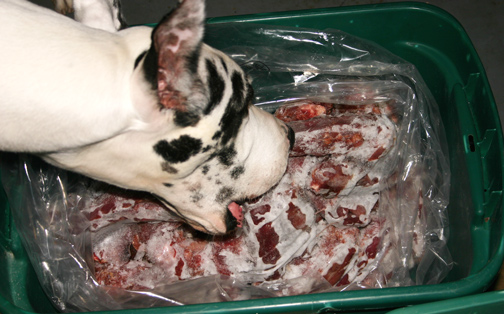
(with Skyy unsuccessfully trying to sneak one)
Thaw the bulk order enough to enable repackaging in smaller quantities. Repackaging methods vary. I use Ziplocs and repackage in meal size quantities. After feeding one meal, I simply pull the next meal out of the deep freeze and leave it in a container on the counter to thaw for the following meal.
A deep freeze is extremely useful – almost a must have – especially if feeding multiple dogs and/or larger breeds.
If you have friends/relatives that hunt or butcher, be sure to hit them up for any left over “parts”!
I am primarily purchasing from Big Dan’s Trucking in MN. We make the 4-hour one-way drive about once every 4-6 weeks. We have a coop of sorts (a fairly local group of raw feeders), to share the trips so no one has make every trip. I have also used My Pet Carnivore, a company that serves the Midwest, delivering a variety of raw food items. I also purchase from a local restaurant supplier, Potthoff Foods in Des Moines.
Switching from kibble to raw
It is typically recommended to switch cold turkey, not using any sort of transition period. Raw foods and kibble do not digest at the same rate (raw digests much quicker), so some have theorized this could potentially cause issues by forcing the raw foods to stay in the digestive track longer. I don’t know how much truth is in that, but I also do not believe a gradual transition provides any benefits.
The introduction of raw foods is likely to cause loose stools, regardless if there is a gradual transition, so there is no benefit is trying a gradual method.
Some dogs are slow to warm up to the idea of these newly presented raw foods, so not offering their normal kibble can help. A little hunger is great encouragement to try something new.
You might even fast the dog for a meal or two prior to offering the first raw foods. Do not be discouraged if your dog refuses the raw food at first. Give them 15 minutes for meal time and if they do not eat, just pick up and put in the frig until the next meal. Do not offer any other food until the next meal, then offer the same piece of meat again. For some more stubborn dogs, this process could easily take several meals. Don’t worry, your dog will not starve to death during the switch!
Start with one protein source at a time, initially avoiding fatty meats, like pork. It’s common to start with chicken backs due to the soft bones. Pull the skin and any excess fat off the meat, especially if your dog is prone to loose stools.
Anticipate loose stools at first. It’s normal. The stools will likely be smelly and might contain some small bone fragments. Normal. Often times the stools have a mucus-like quality. Normal. The dog may vomit or regurgitate. Normal.
If the dog regurgitates shortly after consuming the food, you can allow the dog to re-eat. Gross, yes, however that is just the dog learning to chew this new food. They will not do this long term on the raw diet. Regurgitating is different than vomiting, which occurs after digestion has started.
Allow the dog to get used to that protein source before adding a new kind of meat. Don’t add more than one protein source a week for the first several weeks. Due to the richness of organ meat, do not feed any for the first month or so.
Switching to such a vastly different food is why diarrhea and vomiting can occur. Not all dogs experience this, but it is common enough to warrant the upfront reassurance. Once you get past that first week or two, things get better. The benefits of the raw diet are worth it!
The information on this page is meant as an introduction to raw.
Please, do thorough research, via multiple sources, about what it takes to create a
healthy raw diet before starting your pet on raw.
